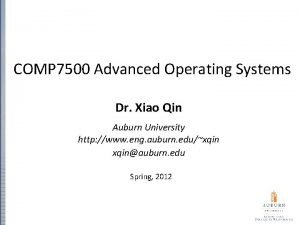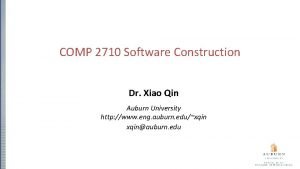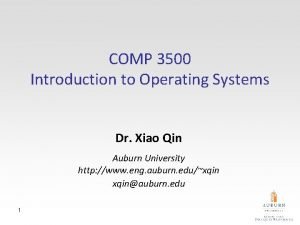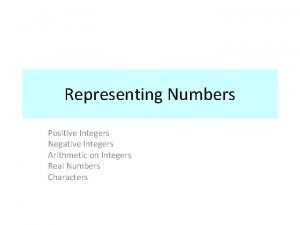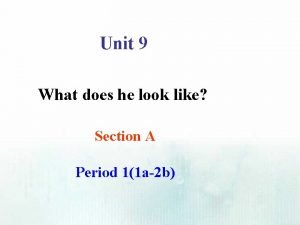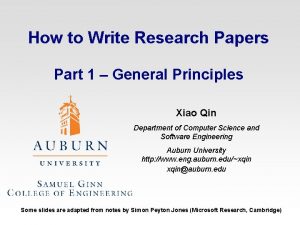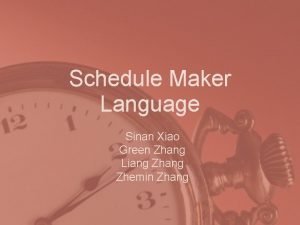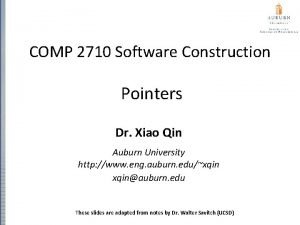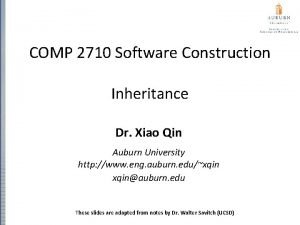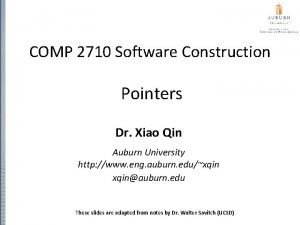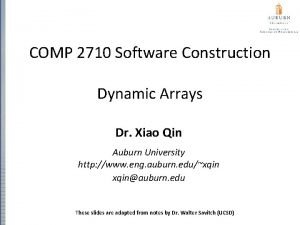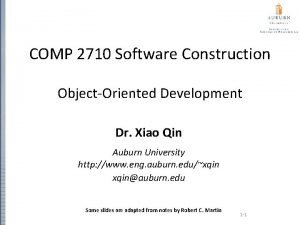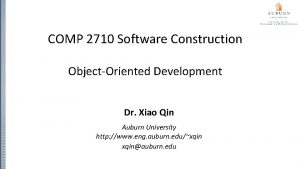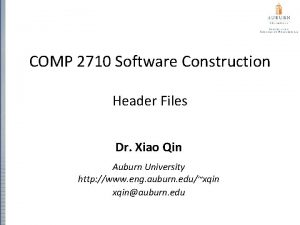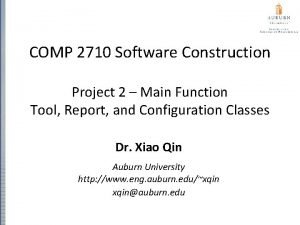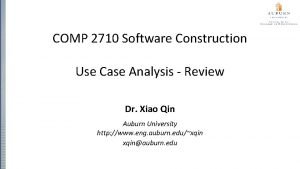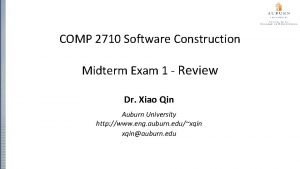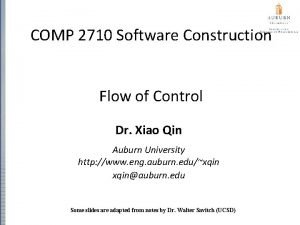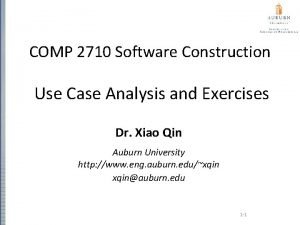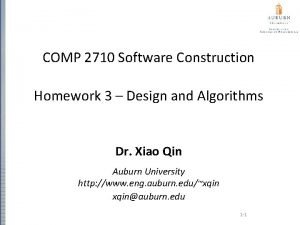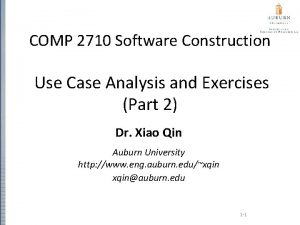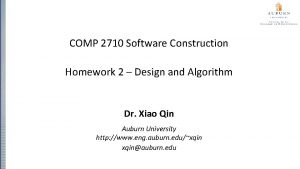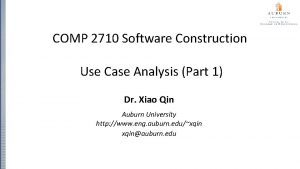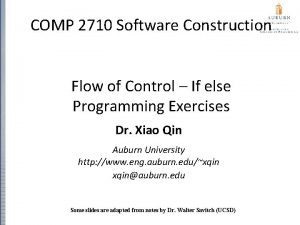COMP 2710 Software Construction Classes Dr Xiao Qin






















- Slides: 22

COMP 2710 Software Construction Classes Dr. Xiao Qin Auburn University http: //www. eng. auburn. edu/~xqin@auburn. edu These slides are adapted from notes by Dr. Walter Savitch (UCSD) 1 -1

Class Definitions • Defined similar to structures • Example: class Day. Of. Year name of new class type { public: void output(); member function! int month; int day; }; • Notice only member function’s prototype – Function’s implementation is elsewhere Copyright © 2008 Pearson Addison-Wesley. All rights reserved. 6 -2

Declaring Objects • Declared same as all variables – Predefined types, structure types • Example: Day. Of. Year today, birthday; • Declares two objects of class type Day. Of. Year • Objects include: – Data • Members month, day – Operations (member functions) • output() Copyright © 2008 Pearson Addison-Wesley. All rights reserved. 6 -3

Class Member Access • Members accessed same as structures • Example: today. month today. day – And to access member function: today. output(); Invokes member function Copyright © 2008 Pearson Addison-Wesley. All rights reserved. 6 -4

Class Member Functions • Must define or "implement" class member functions • Like other function definitions – Can be after main() definition – Must specify class: void Day. Of. Year: : output() {…} • : : is scope resolution operator • Instructs compiler "what class" member is from • Item before : : called type qualifier Copyright © 2008 Pearson Addison-Wesley. All rights reserved. 6 -5

Public and Private Members • Data in class almost always designated private in definition! – Hide data from user – Allow manipulation only via operations • Which are member functions • Public items (usually member functions) are "user-accessible" 6 -6

Public and Private Example • Modify previous example: class Day. Of. Year { public: void input(); void output(); private: int month; int day; }; • Data now private • Objects have no direct access 6 -7

Public and Private Example 2 • Given previous example • Declare object: Day. Of. Year today; • Object today can ONLY access public members – cin >> today. month; // NOT ALLOWED! – cout << today. day; // NOT ALLOWED! – Must instead call public operations: • today. input(); • today. output(); 6 -8

Accessor and Mutator Functions • Object needs to "do something" with its data • Call accessor member functions – Allow object to read data – Also called "get member functions" – Simple retrieval of member data • Mutator member functions – Allow object to change data – Manipulated based on application 6 -9

Separate Interface and Implementation • User of class need not see details of how class is implemented – Principle of OOP encapsulation • User only needs "rules" – Called "interface" for the class • In C++ public member functions and associated comments • Implementation of class hidden – Member function definitions elsewhere – User need not see them 6 -10

Structures versus Classes • Structures – Typically all members public – No member functions • Classes – Typically all data members private – Interface member functions public • Technically, same – Perceptionally, very different mechanisms 6 -11

Thinking Objects • Focus for programming changes – Before algorithms center stage – OOP data is focus • Algorithms still exist – They simply focus on their data – Are "made" to "fit" the data • Designing software solution – Define variety of objects and how they interact 6 -12

Summary • Class used to combine data and functions into single unit -> object • Member variables and member functions – Can be public accessed outside class – Can be private accessed only in a member function’s definition • Class and structure types can be formal parameters to functions 6 -13

COMP 2710 Software Construction Constructors and Other Tools (Part 1) Dr. Xiao Qin Auburn University http: //www. eng. auburn. edu/~xqin@auburn. edu These slides are adapted from notes by Dr. Walter Savitch (UCSD)

Constructors • Initialization of objects – Initialize some or all member variables – Other actions possible as well • A special kind of member function – Automatically called when object declared • Very useful tool – Key principle of OOP 7 -15

Constructor Definitions • Constructors defined like any member function – Except: 1. Must have same name as class 2. Cannot return a value; not even void! Why cannot return a value? Why must have the same name as the class? 7 -16

Constructor Definition Example • Class definition with constructor: – class Day. Of. Year { public: Day. Of. Year(int month. Value, int day. Value); //Constructor initializes month & day void input(); void output(); … private: int month; int day; } 7 -17

Constructor Notes • Notice name of constructor: Day. Of. Year – Same name as class itself! • Constructor declaration has no return-type – Not even void! • Constructor in public section – It’s called when objects are declared – If private, could never declare objects! 7 -18

Calling Constructors • Declare objects: Day. Of. Year date 1(7, 4), date 2(5, 12); • Objects are created here – Constructor is called – Values in parens passed as arguments to constructor – Member variables month, day initialized: date 1. month 7 date 2. month 5 date 1. dat 4 date 2. day 12 7 -19

Constructor Equivalency • Consider: – Day. Of. Year date 1, date 2 date 1. Day. Of. Year(7, 4); date 2. Day. Of. Year(5, 5); // ILLEGAL! • Seemingly OK… – CANNOT call constructors like other member functions! 7 -20

Constructor Code • Constructor definition is like all other member functions: Day. Of. Year: : Day. Of. Year(int month. Value, int day. Value) { month = month. Value; day = day. Value; } • Note same name around : : – Clearly identifies a constructor • Note no return type – Just as in class definition 7 -21

Alternative Definition • Previous definition equivalent to: Day. Of. Year: : Day. Of. Year(int month. Value, int day. Value) : month(month. Value), day(day. Value) {…} • Third line called "Initialization Section" • Body left empty • Preferable definition version 7 -22
 Xiao qin auburn
Xiao qin auburn Xiao qin auburn
Xiao qin auburn Xiao qin auburn
Xiao qin auburn Xiao qin auburn
Xiao qin auburn Xiao team comp
Xiao team comp 2710 19 43
2710 19 43 Convert 2710 to another number in base three
Convert 2710 to another number in base three 2710 gtip
2710 gtip Exercicios de classe e subclasse das palavras
Exercicios de classe e subclasse das palavras Pre ap classes vs regular classes
Pre ap classes vs regular classes Angela xiao
Angela xiao Dr huafeng shen
Dr huafeng shen Xiao height
Xiao height Xiao outline
Xiao outline Scarlett xiao
Scarlett xiao 510631
510631 Xiao
Xiao Cunde xiao
Cunde xiao Google zhang liang games
Google zhang liang games Richard xiao
Richard xiao Xiao tu
Xiao tu Hong xiao semiconductor
Hong xiao semiconductor Xiao animation
Xiao animation


